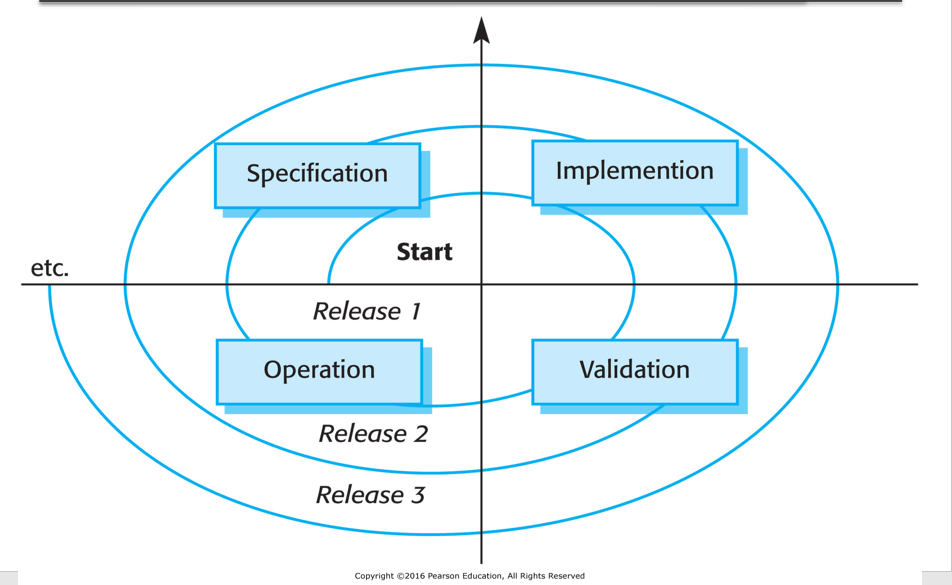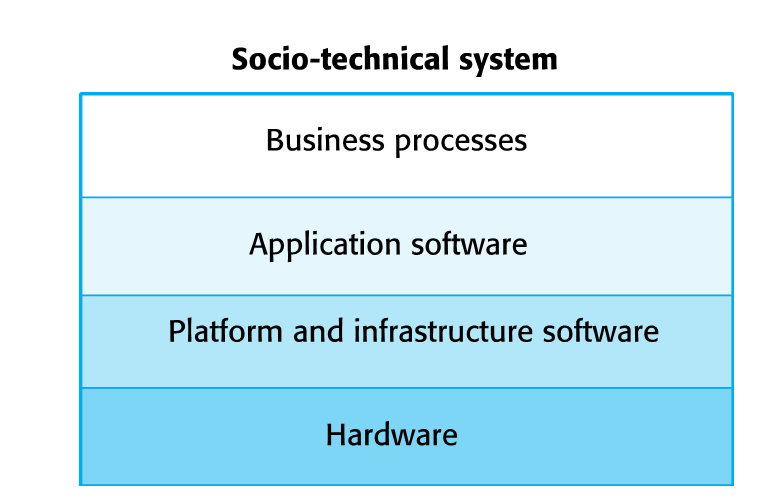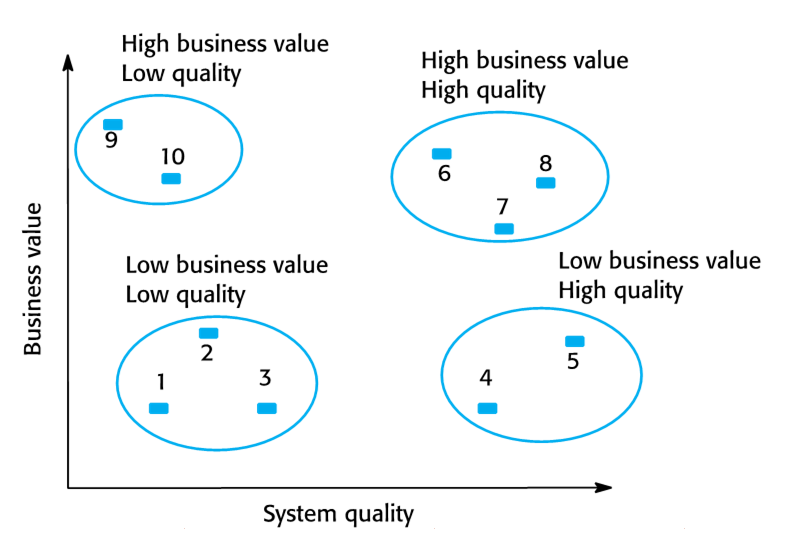Chapter 9: Software Evolution
1/49
There's no tags or description
Looks like no tags are added yet.
Name | Mastery | Learn | Test | Matching | Spaced |
|---|
No study sessions yet.
50 Terms
Software change
It is inevitable.
New requirements emerge when the software is used
The business environment changes;
Errors must be repaired;
New computers and equipment is added to the system;
The performance or reliability of the system may have to be improved.
A key problem for all organizations is implementing and managing change to their existing software systems.
Spiral model of development and evolution
This model

Software evolution processes depend on…
The type of software being maintained
The development processes used
The skills and experience of the people involved
Proposals for change
The driver for the system of evolution
Should be linked with components that are affected by the change
Allows estimation of cost and impact of change
System Lifetime
Change identification and evolution continues throughout this
Change Implementation
Iteration of the development process where the revisions to the system are designed, implemented and tested
A critical difference is that the first stage of change implementation may involve program understanding, especially if the original system developers are not responsible for the change implementation or have gone
During the program understanding phase, you have to understand how the program is structured, how it delivers functionality and how the proposed change(s) might affect the program
The emergency repair process
This model

Agile methods and evolution
Agile methods are based on incremental development so the transition from development to evolution is a seamless one.
Evolution is simply a continuation of the development process based on frequent system releases.
Automated regression testing is particularly valuable when changes are made to a system.
Changes should be expressed as additional user stories.
Handover problems
Short definition: When changing from one development approach to another (agile, plan-based) can cause problems
Where the development team has used an agile approach, but they are unfamiliar with agile methods and prefer a plan-based approach.
The evolution team may expect detailed documentation to support evolution, and this is not produced in agile processes.
Where a plan-based approach has been used for development, but the evolution team prefer to use agile methods.
The evolution team may have to start from scratch developing automated tests and the code in the system may not have been refactored and simplified as is expected in agile development.
Legacy systems
Legacy systems are older systems that rely on languages and technology that are no longer used for new systems development.
Legacy software may be dependent on older hardware, such as mainframe computers and may have associated legacy processes and procedures.
Legacy systems are not just software systems but are broader socio-technical systems that include hardware, software, libraries and other supporting software and business processes.
Legacy system layers
This model

Legacy system replacement
Legacy system replacement is risky and expensive so businesses continue to use these systems
System replacement is risky for a number of reasons
Lack of complete system specification
Tight integration of system and business processes
Undocumented business rules embedded in the legacy system
New software development may be late and/or over budget
Legacy system change
Legacy systems are expensive to change for several reasons:
No consistent programming style
Use of obsolete programming languages with few people available with these language skills
Inadequate system documentation
System structure degradation
Program optimizations may make them hard to understand
Data errors, duplication and inconsistency
Legacy system management
Organizations that rely on legacy systems must choose a strategy for evolving these systems
Scrap the system completely and modify business processes so that it is no longer required
Continue maintaining the system
Transform the system by re-engineering to improve its maintainability
Replace the system with a new system
The strategy chosen should depend on the system quality and its business value.
Legacy assessment example
This model

Legacy system categories
Low quality, low business value
These systems should be scrapped.
Low-quality, high-business value
These make an important business contribution but are expensive to maintain. Should be re-engineered or replaced if a suitable system is available.
High-quality, low-business value
Replace with COTS, scrap completely or maintain.
High-quality, high business value
Continue in operation using normal system maintenance.
Business value assessment
Assessment should take different viewpoints into account
System end-users;
Business customers;
Line managers;
IT managers;
Senior managers.
Interview different stakeholders and collate results.
Issues in business value management
The use of the system
If systems are only used occasionally or by a small number of people, they may have a low business value.
The business processes that are supported
A system may have a low business value if it forces the use of inefficient business processes.
System dependability
If a system is not dependable and the problems directly affect business customers, the system has a low business value.
The system outputs
If the business depends on system outputs, then the system has a high business value.
System quality assessment
Business process assessment
How well does the business process support the current goals of the business?
Environment assessment
How effective is the system’s environment and how expensive is it to maintain?
Application assessment
What is the quality of the application software system?
Business process assessment
Use a viewpoint-oriented approach and seek answers from system stakeholders
Is there a defined process model and is it followed?
Do different parts of the organisation use different processes for the same function?
How has the process been adapted?
What are the relationships with other business processes and are these necessary?
Is the process effectively supported by the legacy application software?
Example - a travel ordering system may have a low business value because of the widespread use of web-based ordering.
Factors used in environment assessment
Supplier stability
Failure rate
Age
Performance
Support Requirements
Maintenance Costs
Interoperability
Understandability
Documentation
Data
Performance
Programming Language
Configuration Management
Test Data
Personnel skills
Supplier stability
Is the supplier still in existence? Is the supplier financially stable and likely to continue in existence? If the supplier is no longer in business, does someone else maintain the systems?
Failure Rate
Does the hardware have a high rate of reported failures? Does the support software crash and force system restarts?
Age
How old is the hardware and software? The older the hardware and support software, the more obsolete it will be. It may still function correctly but there could be significant economic and business benefits to moving to a more modern system.
Performance
Is the performance of the system adequate? Do performance problems have a significant effect on system users?
Support Requirements
What local support is required by the hardware and software? If there are high costs associated with this support, it may be worth considering system replacement.
Maintenance Costs
What are the costs of hardware maintenance and support software licenses? Older hardware may have higher maintenance costs than modern systems. Support software may have high annual licensing costs.
Interoperability
Are there problems interfacing the system to other systems? Can compilers, for example, be used with current versions of the operating system? Is hardware emulation required?
Understandability
How difficult is it to understand the source code of the current system? How complex are the control structures that are used? Do variables have meaningful names that reflect their function?
Documentation
What system documentation is available? Is the documentation complete, consistent, and current?
Data
Is there an explicit data model for the system? To what extent is data duplicated across files? Is the data used by the system up to date and consistent?
Performance
Is the performance of the application adequate? Do performance problems have a significant effect on system users?
Programming Language
Are modern compilers available for the programming language used to develop the system? Is the programming language still used for new system development?
Configuration management
Are all versions of all parts of the system managed by a configuration management system? Is there an explicit description of the versions of components that are used in the current system?
Test data
Does test data for the system exist? Is there a record of regression tests carried out when new features have been added to the system?
Personnel skills
Are there people available who have the skills to maintain the application? Are there people available who have experience with the system?
System measurement
You may collect quantitative data to assess the quality of the application system
The number of system change requests; The higher this accumulated value, the lower the quality of the system.
The number of different user interfaces used by the system; The more interfaces, the more likely it is that there will be inconsistencies and redundancies in these interfaces.
The volume of data used by the system. As the volume of data (number of files, size of database, etc.) processed by the system increases, so too do the inconsistencies and errors in that data.
Cleaning up old data is a very expensive and time-consuming process
Software maintenance
Modifying a program after it has been put into use.
The term is mostly used for changing custom software. Generic software products are said to evolve to create new versions.
Maintenance does not normally involve major changes to the system’s architecture.
Changes are implemented by modifying existing components and adding new components to the system.
Types of maintenance
Fault repairs
Changing a system to fix bugs/vulnerabilities and correct deficiencies in the way meets its requirements.
Environmental adaptation
Maintenance to adapt software to a different operating environment
Changing a system so that it operates in a different environment (computer, OS, etc.) from its initial implementation.
Functionality addition and modification
Modifying the system to satisfy new requirements.
Maintenance Costs
It is usually more expensive to add new features to a system during maintenance than it is to add the same features during development
A new team has to understand the programs being maintained
Separating maintenance and development means there is no incentive for the development team to write maintainable software
Program maintenance work is unpopular
Maintenance staff are often inexperienced in older languages and have limited domain knowledge.
As programs age, their structure degrades and they become harder to change
Maintenance prediction
Concerned with assessing which parts of the system may cause problems and have high maintenance costs
Change acceptance depends on the maintainability of the components affected by the change;
Implementing changes degrades the system and reduces its maintainability;
Maintenance costs depend on the number of changes and costs of change depend on maintainability.
Change predictions
Predicting the number of changes requires and understanding of the relationships between a system and its environment.
Tightly coupled systems require changes whenever the environment is changed.
Factors influencing this relationship are
Number and complexity of system interfaces
Number of inherently volatile system requirements
The business processes where the system is used
Complexity Metrics
Predictions of maintainability can be made by assessing the complexity of system components.
Studies have shown that most maintenance effort is spent on a relatively small number of system components.
Complexity depends on
Complexity of control structures
Complexity of data structures
Object, method (procedure) and module size
Process Metrics
Process metrics may be used to assess maintainability
Number of requests for corrective maintenance
Average time required for impact analysis
Average time taken to implement a change request
Number of outstanding change requests
If any or all of these is increasing, this may indicate a decline in maintainability.
Advantages of re-engineering
Reduced risk
There is a high risk in new software development. There may be development problems, staffing problems and specification problems.
Reduced cost
The cost of re-engineering is often significantly less than the costs of developing new software.
Re-engineering process
This model

Re-engineering process factors
The quality of the software to be reengineered.
The tool support available for reengineering.
The extent of the data conversion which is required.
The availability of expert staff for reengineering.
This can be a problem with old systems based on technology that is no longer widely used.
Refactoring
Refactoring is the process of making improvements to a program to slow down degradation through change.
You can think of refactoring as ‘preventative maintenance’ that reduces the problems of future change.
Refactoring involves modifying a program to improve its structure, reduce its complexity or make it easier to understand.
When you refactor a program, you should not add functionality but rather concentrate on program improvement.
Refactoring and re-engineering
Reengineering takes place after a system has been maintained for some time and maintenance costs are increasing. You use automated tools to process and re-engineer a legacy system to create a new system that is more maintainable.
Refactoring is a continuous process of improvement throughout the development and evolution process. It is intended to avoid the structure and code degradation that increases the costs and difficulties of maintaining a system.
‘Bad smells‘ in programming code
Duplicate code
The same or very similar code may be included at different places in a program. This can be removed and implemented as a single method or function that is called as required.
Long methods
If a method is too long, it should be redesigned as a number of shorter methods.
Switch (case) statements
These often involve duplication, where the switch depends on the type of a value. The switch statements may be scattered around a program. In object-oriented languages, you can often use polymorphism to achieve the same thing.
Data clumping
Data clumps occur when the same group of data items (fields in classes, parameters in methods) re-occur in several places in a program. These can often be replaced with an object that encapsulates all of the data.
Speculative generality
This occurs when developers include generality in a program in case it is required in the future. This can often simply be removed.